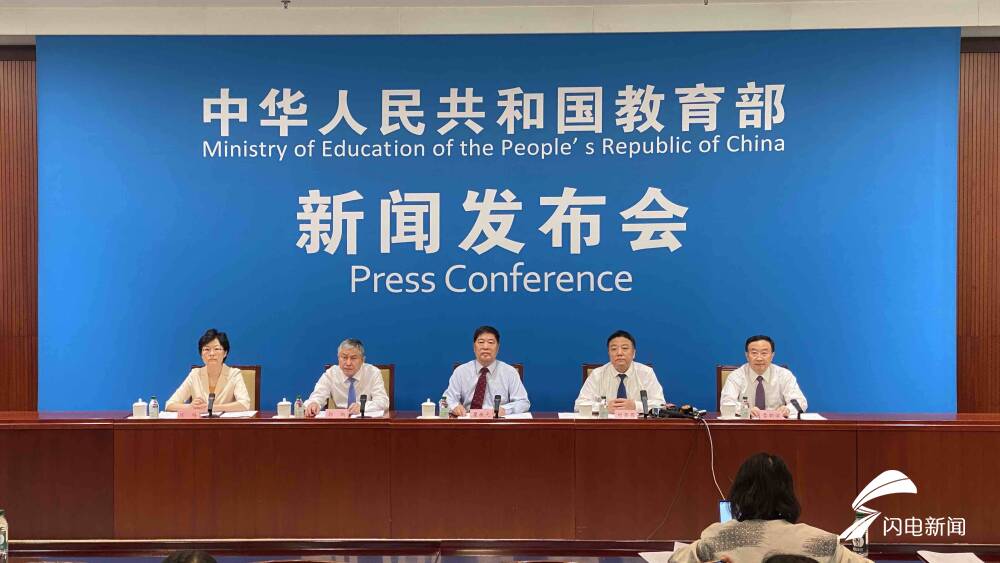In 2021, the total investment of education is close to 6 trillion yuan in my country's fiscal education expenditure accounted for GDP proportion for 10 consecutive years to maintain more than 4%
Author:Qilu.com Time:2022.09.27
Qilu.com • Lightning News September 27th. The Ministry of Education introduced at the "Ten Years of Education" series held this morning that since the 18th National Congress of the Communist Party of China, the party and the state have preferred education investment, and national fiscal education expenditure expenditures The proportion of GDP has remained above 4%for 10 consecutive years.

Guo Peng, director of the Finance Department of the Ministry of Education, introduced that the national fiscal education expenditure accounted for 4%of GDP. This is the first time in my country to achieve it in 2012 and consolidate for 10 consecutive years. In the past ten years, especially since the epidemic, the downward pressure on my country's economic downlink has increased year by year, and the contradiction between fiscal revenue and expenditure is very prominent, but the financial investment in education has always insisted on increasing only year by year. The cumulative expenditure of national fiscal education for ten years was 3.3.5 trillion yuan, an average annual increase of 9.4%, which was higher than the average annual nample increase (8.9%) and the average annual annual increase in the income of general public budgets (6.9%) during the same period. Although this proportion is high or low in different years, it has never been lower than 4%. 4%drive the base of education input to continue to increase. Whether it is total investment, or financial, general public budgets, non -finance and other channels for education, it has doubled in ten years. The first double is "total investment". The total investment in education in the country was 2.4 trillion yuan in 2011, and in 2021 reached 5.8 trillion yuan, which was 2.4 times that of 2011, an average annual increase of 9.3%. The second double is "fiscal." The national fiscal education funding, less than 1,200 billion yuan in 2011, reached 4.6 trillion yuan in 2021, 2.5 times that of 2011, an average annual increase of 9.4%. The third double is "general public budget". The general public budget education expenditure in the country was 1.6 trillion yuan in 2011, reaching 3.7 trillion yuan in 2021, 2.3 times in 2011, an average annual increase of 8.8%. The fourth double is "non -fiscal." Non -fiscal education funds in the country, less than 600 billion yuan in 2011, reached 1.2 trillion yuan in 2021, 2.3 times in 2011, an average annual increase of 8.6%.
After ten years of hard work, the basic pattern of the education investment base in 2021 is: the total investment exceeds 5 trillion yuan, close to 6 trillion yuan; the fiscality exceeds 4 trillion yuan, close to 5 trillion yuan; the general public budget exceeds 30,000 100 million yuan, close to 4 trillion yuan; non -fiscal exceeds 1 trillion yuan. Guo Peng said that the base is large, which means that the material foundation that guarantees the development of education is thicker. 80%of the total investment in education funds from the country comes from national fiscal education. Government investment is the largest source of educational funding. 80%of the national fiscal education funds come from general public budget education funds. Education has become the largest expenditure of general public budgets. 80%of the national general budget education funds are from local. Local governments are the largest subject of educational expenditure. Over the past ten years, the system of government investment and multi -channel raising education funding has been further consolidated and improved.
While the total amount of education funding has doubled, the level of student average funding also achieves historic leapfrogging, and the level of financial protection has increased significantly. In 2021, the average public budget education expenditure of the number of students in the country, 9506 yuan in kindergarten, 12,381 yuan for ordinary primary schools, 17,772 yuan for ordinary junior high schools, 18,809 yuan for ordinary high schools, 17095 yuan in secondary vocational schools, and 22586 yuan for ordinary colleges and universities, respectively in 2011, respectively. 3.3 times, 2.2 times, 2.4 times, 2.5 times, 2.1 times, 1.5 times.其中,幼儿园年均增长12.6%,在各教育阶段中增幅最高、增速最快;普通小学年均增长8.3%;普通初中年均增长8.9%;普通高中年均增长9.8%,增幅仅次于Kindergarten, the level of expenditure is second only to ordinary universities; secondary vocational schools have an average annual growth of 7.9%; although the average annual growth rate of ordinary universities is the lowest and 4.1%, the expenditure level is the highest, exceeding 20,000 yuan.
From a structural point of view, the increase in education in the past ten years is 3 trillion yuan, an average of 300 billion yuan per year. Where do these money use? Guo Peng introduced that more than half of education at all levels is used for compulsory education; more than half of each expenditure is used for teachers' salaries; more than half of each region, more than half of them in the central and western regions. The funds for compulsory education in national fiscal education have reached 2.3 trillion yuan in 2021, an average annual increase of 8.9%; in the past ten years, the proportion has remained more than half, and the proportion of education at all levels is the largest. The national fiscal education funding for preschool education has reached 270 billion yuan in 2021, an average annual growth of 20.6%, and the fastest growth in education at all levels; the proportion of 5.9%, an increase of 3.7 from 2.2%in 2011, 3.7 percentage point. The national fiscal education funds are funded in the central and western regions, accounting for more than 50%. The central government's funding for local education transfer payment funds for the central and western regions accounts for more than 80%. In particular, new education funds are given priority to support the implementation of education and poverty alleviation. The average annual growth rate of fiscal education funds in deep poverty -stricken areas such as "three districts and three states" reached 12.2%, exceeding the national average of 2.8 percentage points. Over the past ten years, the student funding policy and standard system have been continuously improved, and all sections from preschool education to graduate education, all public schools, and all family -run students' economic difficulties "three full coverage". The total amount of student funding across the country exceeded 2 trillion yuan, and the annual funding amount increased from 132.2 billion yuan in 2012 to 266.8 billion yuan in 2021, which turned it over. Students with particular difficulties such as "establishment of files" at all levels of education at all levels have been given priority funding to ensure that a student is not allowed to lose school due to family economic difficulties. While ensuring the normal operation of the school, the purchase of equipment, the construction of the school building, and the student funding, insist on improving the wages and benefits of teachers as the first priority guarantee in the financial education expenditure, and adhere to the average salary income level of compulsory education teachers. The top priority of the leadership of civil servants' "legal requirements is given priority. Among various expenditures, the proportion of the expenses of faculty and staff is the highest. In 2021, it reached 61.6%, an increase of 12.9 percentage points from 2011, the largest increase; an average annual increase of 12.1%, significantly higher than the expenditure of fiscal education expenditure expenditures. In the average growth rate, the focus of educational expenditure gradually shifted from investing in objects to more investment.
Lightning News reporter Wang Zhiqin Beijing report
- END -
204 financial institutions settled in Qianhai Financial City

In recent years, Qianhai has always firmly grasped the strategic positioning given...
IFF: Global Expert Dao Dao's new momentum of economic growth
21st Century Business Herald reporter Lei Chen Beijing reportOur reporter learned that the 24th academic conference of the International Financial Forum (IFF) held on September 8 learned that a number